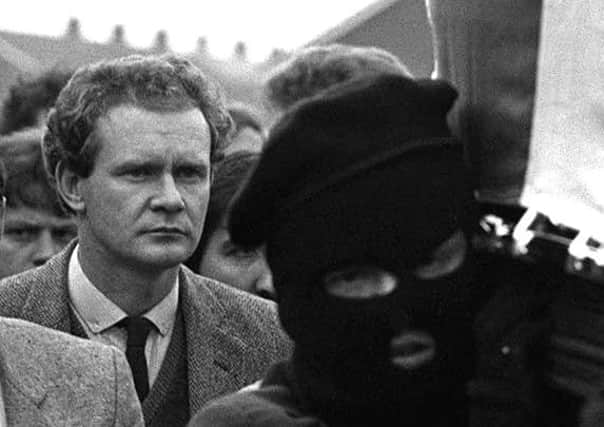File including religion of IRA targets '˜was destined for McGuinness'


Amid considerable media interest in Mr McGuinness’ transition from violent republican to political statesman, the News Letter has sought to examine some of the facts around the period when he has acknowledged being an IRA member.
He is understood to have joined the IRA some time in 1970, and claims to have left in 1974 (although this claim has been disputed; for example, Irish justice minister Michael McDowell named him as a member of its ruling Army Council in 2005 in a radio broadcast).
Advertisement
Hide AdAdvertisement
Hide AdOne of the key events of this 1970-1974 period was his capture by An Garda Siochana, and his trial in 1973 on paramilitary charges.
Although it appears the News Letter at the time did not have coverage of the trial, which took place in Dublin, the event is recounted in the book ‘Martin McGuinness: From Guns to Government’, written by Kathryn Johnston and the late Liam Clarke.
It stated that he and another IRA man had abandoned a red Ford Cortina and were later seized by Irish police who accused them of having 250lb (about 114kg) of gelignite explosive, and 4,750 bullets.
This was some time at the very end of 1972, it said.
It stated that both McGuinness and the other man were convicted of IRA membership, but acquitted of four unspecified munitions charges.
Advertisement
Hide AdAdvertisement
Hide AdThey got a six months in jail each, but the book also stated they were freed by mid-May for “good behaviour”.
It quotes McGuinness saying in court at the time, on January 29: “In Derry city it is a known fact that every citizen killed has been killed by the British Army or the RUC. For over two years I was an officer of the Derry brigade of the IRA.
“We have fought against the killing of our people. My colleagues have been arrested and tortured and some were shot unarmed by British troops...
“I am a member of the Derry brigade of the IRA, and I am very, very proud of it.”
Advertisement
Hide AdAdvertisement
Hide AdAbout six months before his declaration of pride in the organisation, the IRA had massacred nine civilians (Catholics and Protestants alike) in co-ordinated multiple bombings in the tiny village of Claudy, just to the south-east of Londonderry.
In addition to that case against McGuinness directly, the book also quotes from a Londonderry court case (dated as January 10, and also apparently in 1973) concerning an 18-year-old IRA “courier”.
The book stated that the RUC caught him with an envelope containing “lists of policemens’ homes, car registrations, descriptions of individual policemen and their families, along with their movements, and details of the policemens’ religions”.
It also contained “a note of shops in Derry which were to have incendiary devices planted in them the following Saturday”, and a recommendation for one IRA company chief to “kill at least two British soldiers a week”.
Advertisement
Hide AdAdvertisement
Hide AdThe account of the court hearing stated that the courier had “been ordered to deliver the envelope to Martin McGuinness in Buncrana, but was unaware of the contents”.
A study of the Sutton index of deaths, published online by the University of Ulster, demonstrates Mr McGuinness’ claim that only UK state forces killed “citizens” within Londonderry city was incorrect.
As well as a large number of military deaths (including the abduction and murder of off-duty Catholic UDR man Thomas Callaghan from the Foyle Road on February 17, 1972) attributable to the Provisional IRA in the years leading up to 1973, other fatalities had included Bernadette McCool, nine, and Carol Ann McCool, four, both killed along with two IRA men in a premature explosion in a home in the Creggan area of the city on June 26, 1970.
According to the Sutton list, across the whole Province from the start of 1970 to the end of 1974, the Provisional IRA killed roughly 590 people, including about 170 civilians.